Sightseeing in Nagano: 10 Top Tourist Spots and Natural Attractions

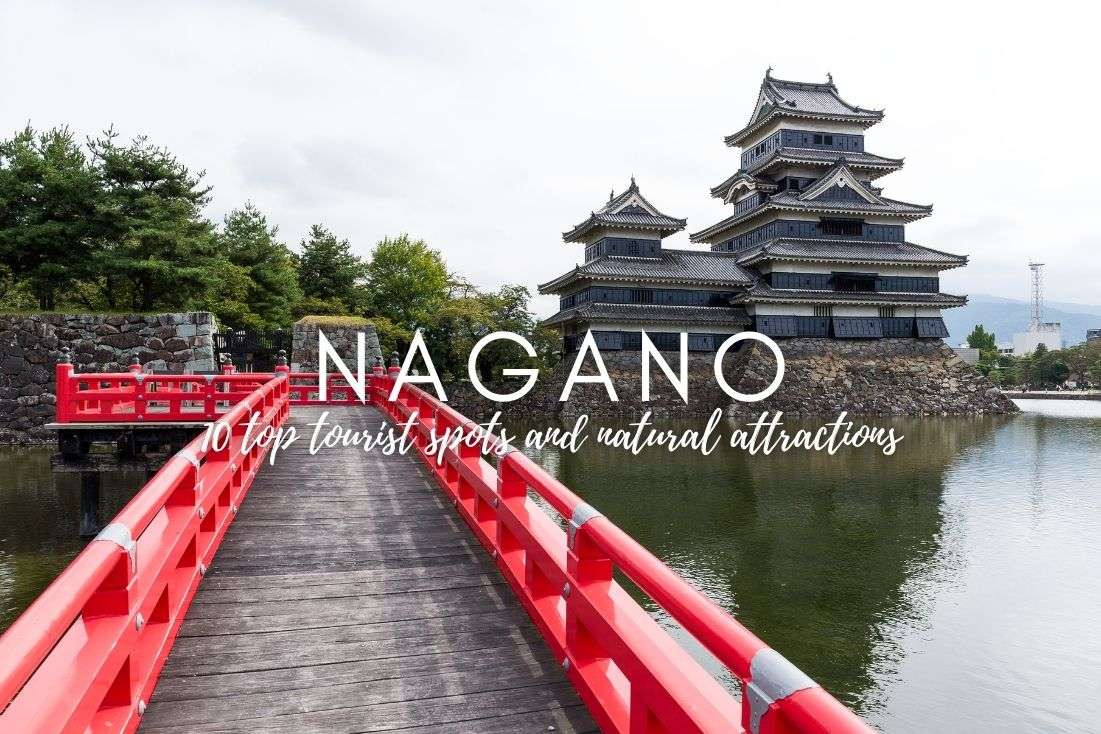
Nagano's right up there with Nikko in my books, and that's saying something, because Nikko is number 1! Heck, maybe Nagano could even tie with Nikko. The “Roof of Japan” is known for its really tall mountains and really old temples. Boomers and older millennials will associate Nagano with the 1998 Winter Olympics, youngsters will just think it’s a winter sports mecca. Oh, and did I mention the snow monkeys?? See, Nagano has something for everyone.
Japan as a whole might not knock your socks off with its culture (no offense, but calling Japan the France of Asia is a stretch)—surprising, I know—, but let me tell you, when it comes to nature, it's a stunner. Nagano is one of the best natural destinations there is, on par with the best of the best worldwide: Hawaii, California, the Alps, and Chile. And if you know me, you know you love me some spectacular nature!
As if that weren’t enough, Nagano's got a cozy little city center, too. And don't even get me started on Matsumoto Castle–double wow! While most Japanese cities might fall short culturally, Nagano's got something special going on, and no, we're not delving into the 1944/45 stuff that “might’ve” put a cultural damper on the more coastal cities. The Japanese don’t like to talk about those years!
Let's keep it light and focus on the good stuff, shall we?
In this article, I’ll attempt to entice you with all things Nagano, and try to show you why this city and its surroundings made me fall head over heels. Obviously, I’ll have you outside of the city most of the time, because that’s where the real Nagano must-sees are.
At the end of the article, I’ll answer some of the basic FAQs that keep anyone planning a trip to Nagano up at night. If you’re already set on going, you can pack your bags and head to another article: Nagano itinerary.
What is Nagano best known for?
Nagano is known for its majestic mountains, ancient temples, and the iconic snow monkeys, and, if you’re old enough, the 1998 Olympics. This is especially true if you’re Czech, because we destroyed Russia in hokey and it was epic. I mean, who wouldn’t want to destroy Russia nowadays... Anyway, Nagano’s a natural wonderland coupled with historical charm. For me, it’s the nature that makes Nagano one of the best, if not the best destination in Japan.
And now I’ll list, in the order of how much I thought they’ll rock your world, Nagano’s top attractions:
1. Togakushi 5 Shrines Hike (the best in the country!)
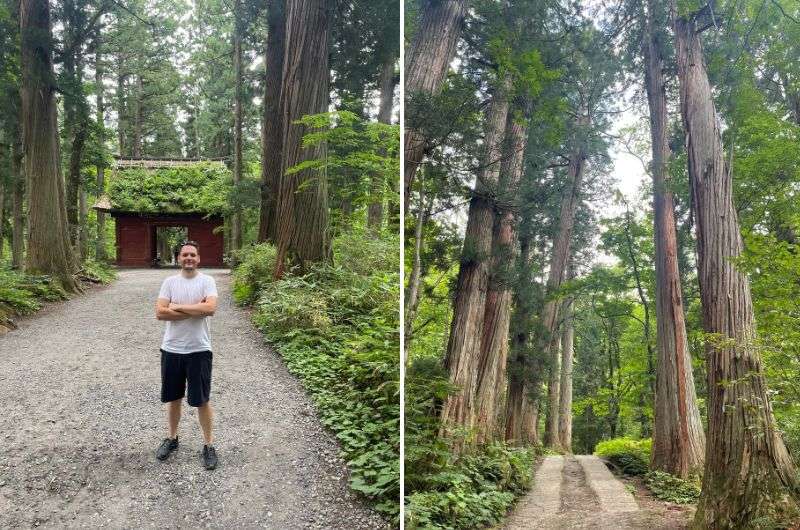
Togakushi 5 Shrines Hike is the best one!
We’re starting this list off with a bang, because Togakushi Kojo isn’t just the top tourist spot in Nagano, it was my favorite place in all of Japan! Because it’s really a bunch of places and activities all rolled into one phenomenal day. It’s not just shrines, but a hike, a lake, a ninja museum, and the wonderful nature that makes Togakushi a must-visit. Yeah, you read that right, a Ninja Museum! I know any kid that grew up in the 90s would kill to see it, because back then, ninjas were bussin’. To add to my glee, there’s an abundance of interesting restaurants in the area. Hey, a traveler’s gotta eat! Have you read my Japanese Food Guide?
Togakushi mountain is home to 5 shrines (with 3 main ones) on Togakushi Mountain, and you can visit them all by hiking a beautiful trail (with lots of stairs). My heart jumped with joy! But there’s more… much more!
But first, a little mythology story: The shrines at Togakushi are on 3 different levels of the mountain trail, and have to do with a story in Japanese mythology. The Sun Goddess Amaterasu was ashamed of her brother’s behavior and hid in a cave (sheesh, even the gods can’t escape Japanese shame culture!). Darkness ensued, so other deities lured her out again with a dance performance. Once she was out, one of the deities grabbed the cave door and threw it away so the Sun Goddess couldn’t shut herself in the cave again.
Each shrine at Togakushi is dedicated to a deity from the Sun Goddess story, and Togakushi Mountain is the stone door from the Goddess’ cave. Togakushi literally means ‘hiding door’.
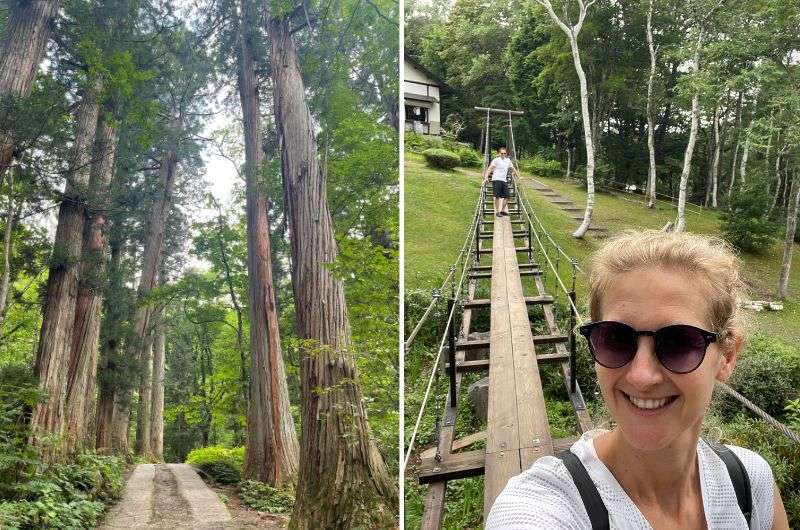
On our way to Ninja Museum through beautiful Togakushi trail
Hiking the Togakushi 5 shrine trail
The Togakushi hiking trail is about 5 km (3 mi) long and takes about 3 hours to walk between the 3 levels where the shrines are: Hokosha and Hinomikosha (lower shrines), Chusha (middle shrine), Kuzuryusha and Okusha (upper shrines). Okusha is the main shrine.
Togakushi is about a 30-minute drive northeast of Nagano. We used the parking areas on the approach to the upper shrine, Okusha. Straight out of the car you’re walking about 40 minutes through a gorgeous forest of giant cedar trees until you get to Zuishinmon gate.
We first headed into the Ninja Museum and Folk Museum, which was quite interesting despite the limited English signage. You learn about rural life, there’s a cool silk exhibit, and one part looked like an uncomfortable shoe collection. But the most fun we had was getting through all the tricks and traps in the Ninja Fun House. My girlfriend kept reliving our quest to get through the roughly 30-minute-long endeavor for the entire rest of our Japan trip!
A side trail from the upper shrine leads you to Kagamiike Lake, but more about that in the next item on this Nagano highlights list.
- You’ll want to allow at least 3 hours for the 5 shrines hike. Add 1.5 hours for the Ninja and Folk Museums and 2 hours for the side-hike lake.
- Museum tickets: JPY 650. There’s no entrance fee for the trail.
2. Kagamiike Lake (Togakushi Mountain)
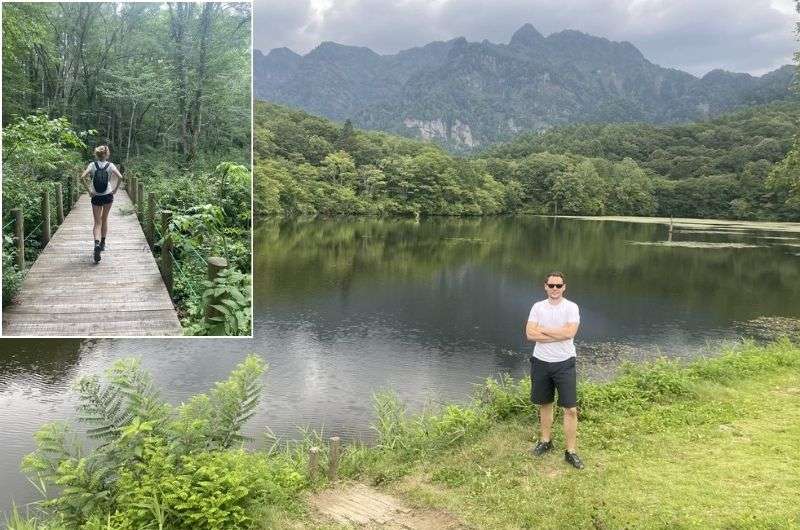
Kagamiike Lake and the trail to it was wonderful, though we didn’t quite get clear skies and the “mirror lake” effect
While you’re at Togakushi hiking up and down the levels to all the shrines, notice a side trail stemming from the main shrine (Okusha). This is like a warp zone that takes you through 2 hours of incredible scenery to some epic views at Kagamiike Lake and back again. This spot very roughly reminded me of views in northern Thailand and Vietnam.
You can easily spend 2 hours just on this hike, though we spent even longer, err, accidentally. The trail wasn’t as clear to us as it should’ve been and the internet was a no-show, so we improvised. No stress though, the forest is very nice! But maybe make note of the Japanese spelling of Kagamiike Lake, because though there are some (Japanese only) signs along the way, we obviously misunderstood them.
To get the most of your Kagamiike Lake adventure, try to plan your visit when the skies are clear. The lake + mountain put on a great mirror effect show for those lucky visitors that manage to come here when there are no clouds. We weren’t part of the lucky few, but still loved it at Kagamiike. Yes, we got lost on the trail and had clouds. Good thing I don’t believe in karma.
For those of you that loath hiking to places that you can just as easily drive to, take note: there is a road right by Kagamiike Lake, and yes, you can drive all the way there. The hiking trail is better though! You’ll have to trust me on that one. Then again, if you’re short on time, you’re allowed to cheat. There’s a lot of sightseeing around Nagano, so chop chop!
The cherry on top at Kagamiike Lake is that there’s a wooden cabin-looking restaurant at the south end of the lake where you can sit, stare at the lake, and eat, all at the same time. We didn’t, because we were already behind schedule thanks to our little lost-in-the-forest escapade, but I’m sure a little coffee and galette will be just the reward for those that manage to navigate the trail without all the detours.
3. Zenkō-ji
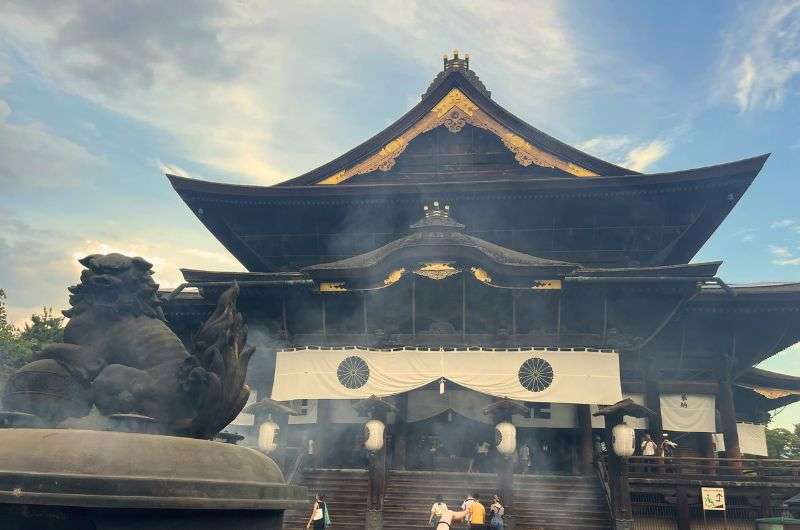
Zenkō-ji
Rounding off my top 3 best places to visit in Nagano is another shrine off my Top temples and shrines in Japan list, Zenkō-ji. It’s thanks to this shrine that Nagano even exists, and as such is conveniently located in Nagano’s city center. To think I was even considering skipping this spot! Even funnier is that during the Edo period, people were supposed to make the pilgramage to Zenko-ji at least once in their lifetime, and here I am, thinking it might be too boring for me.
Needless to say, I ate my thoughts of not visiting Zenko-ji very quickly. It really knocked my socks off with its size—it's massive! Walking up to it, even the gate feels like it's on steroids. The main temple is one of the largest wooden buildings I’ve ever stood before. But it's not just big for the sake of being big; it's stunning too. Toss in those killer mountain backdrops, and it's like hitting the jackpot of temple awesomeness. Definitely a highlight in Nagano for me!
So why is this place, listed on Japan’s list of National Treasures, the birthplace of Nagano? No, it’s not because I said it should be, though I humbly think all governments should listen to my opinions on these things. It’s because while some Japanese cities were built around harbors and some around castles, some—Nagano included—evolved around a temple. Zenko-ji Temple.
It was founded in 642 and houses one important, top-secret item: the first Buddhist statue ever to be brought into Japan.
The statue is so special that nobody’s ever seen it… I’m not even kidding. The thing has been hidden away since they found it and built a temple for it due to the temple’s secrecy commandment. Somehow though, there is a replica of it that gets shown every 6 years to crowds of pilgrims and tourists alike during an event called Gokaicho. Your next chance is in 2028. It’s fascinating to me that people come to this place specifically to see a fake. Just kidding, I guess when it’s 700+ years old, it gains meaning and loses lameness.
As with most temples, there are many buildings on the grounds, including the Zenko-ji History Museum. The Main Hall at Zenko-ji has one peculiar addition to the many, many Buddha statues inside it—an underground passage where people walk in complete darkness trying to touch the “key to paradise” that hangs on one of the walls. Sadly, I cannot report on whether it’s false advertising. Better luck to you guys!
There are two gates you go through on the approach to Zenko-ji: Nioman Gate on Zenkōji Nakamise Street (more on this gem in a moment), and then Sanmon Gate right near the Main Hall. You can climb Sanmon Gate and get nice views of the temple grounds and the cool street that runs towards it.
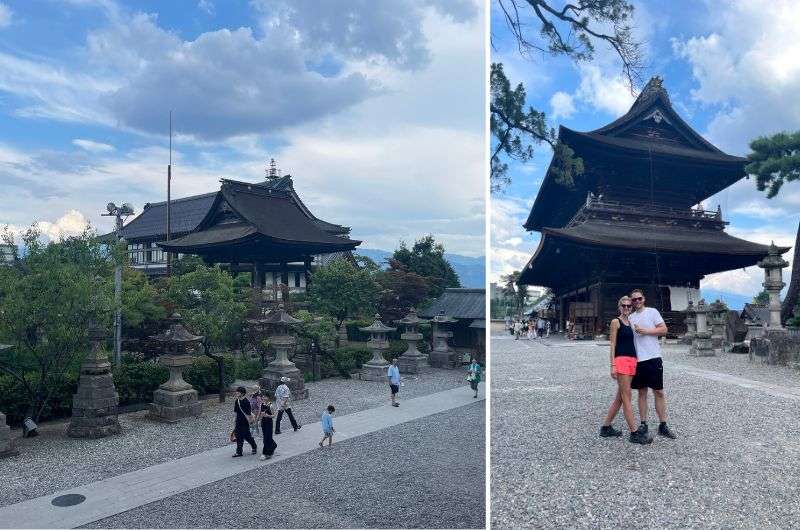
We had so much fun exploring Zenkō-ji
Zenkōji Nakamise Street deserves its own mention, because if you have even the slightest picture of a typical Japanese street in your mind, Nakamise is it. It’s so quaint and cute and traditionally picturesque that you almost forget it’s full of souvenir shops and cafes. And then you see the quaint and cute Starbucks and you realize it’s not 642 anymore.
- Allow 1–2 hours for your Zenko-ji visit (depending if you go into the museum or not)
- Tickets: JPY 500 + JPY 600 for Main Hall
Nagano restaurant alert!
Right before Zenkoji Nakamise Street starts, there’s a fantastic restaurant called Fujia Gohonjin that I still dream about to this day. They even have an English language website and online booking, so you can guarantee you won’t miss your chance to taste their amazing wagyu steak (check my Japanese Food Guide if you have no idea what that is). The restaurant dates back to 1641 and the service there is top-notch. We also tried the fish sauce with vegetables and my taste buds were oohing and aahing. For about USD 100 between the two of us, we had an incredible lunch. Jan strongly recommends!
4. Kamikōchi Valley & Yakedake Hike
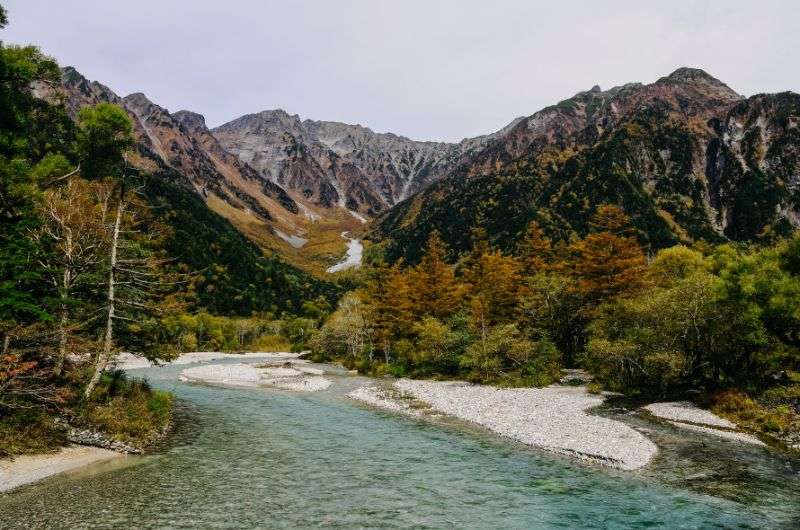
The view really looks like a screensaver—even in real life
If you start looking at Kamikochi photos, you’ll quickly forget you aren’t choosing your new screen saver. It’s just that perfect—and in real life, the turquoise river flowing through this valley brings a piece of those Photoshop-enhanced wallpapers to reality.
This place in the northern Japan Alps is just beautiful. At 1,500 m (4,900 ft), you’ve got mountains surrounding you from all sides, ponds, bridges, fresh air, and no cars. Breathe… you are, indeed, outdoors, and not stuck inside of a laptop. Don’t forget to look up at peaks like Yarigatake and Oku-Hotaka, the 5th and 3rd highest mountains in Japan, respectively.
To truly enjoy Kamikōchi, you’ve got to walk. Hike into the mountains or at least stroll along the river. Here’s the most popular trail for people that like a real hike (others will want to stay in the flat area along the river—see item 6 on this list):
For a properly adventurous day hike, consider the the Yakedake trail. Be warned, Mt. Yake is an active volcano, and while it (probably) won’t erupt, it will most certainly blow some sulfur your way. It’s a pretty unique experience (unless you just spent time at Owakaduni near Hakone which gives not only fuming vents but also magical black eggs that extend your life!).
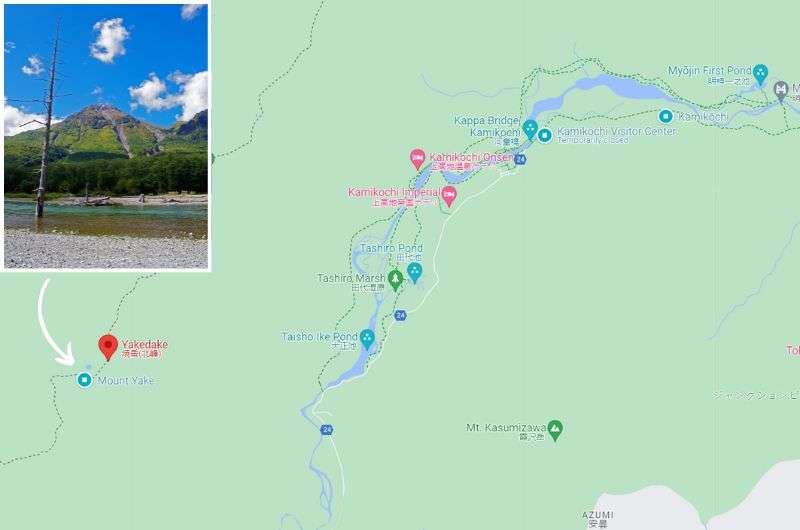
It’s about 6 km (3.8 mi) one way to walk, scramble, and climb some ladders up Mt. Yake
Yakedake hike details:
Hike length: 12.5 km (7.7 miles) out-and-back
Elevation gain: 980 m (3,200 feet)
Difficulty level: Hard
Hiking time: 6 hours
Trailhead: Kamikochi bus terminal Google Maps link
There are plenty of multi-day hikes in Kamikochi, but that’s not how I roll. I roll in and out in a single day. Yakedake is my type of hike. Though a bit long, it’s got just the right amount of punch in the form of scrambling and ladders that makes a tiring 12 km into a fun 12 km (that’s about 7.7 miles).
The first 3 km (1.8 mi) is flat and pleasant, taking you along the river. Then, elevation hits, and it hits pretty hard. You are going up a volcano after all! Enjoy, it’s a great way to experience Japan’s nature.
So great, in fact, that a lot of people embark on this trail, so I’d suggest going in the morning to beat the crowds. Unless you don’t mind a crowd, in which case, go ahead and start at 10 am on an August weekend!
Remember, Kamikochi closes in winter, so you’ll need to plan your visit between mid-April and mid-October.
You’ll need to leave your car at the Sawando parking lot or the Hirayu parking area and then take a 20-minute bus to the national park from there. Parking costs JPY 700 per day, the bus is around JPY 1,200 each way.
5. Matsumoto Castle
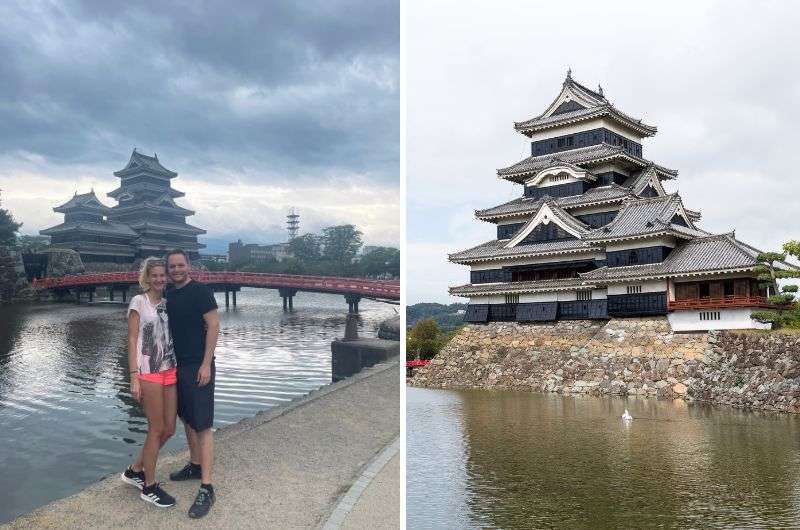
My ninja-loving inner child was awakened at Matsumoto castle
Matsumoto Castle, the oldest in Japan and one of its three most significant, truly lived up to my ninja childhood fantasies. Think less Cinderella, more warrior fortress. There are even live ninjas and samurais roaming the gardens! If that’s not a photo op, I don’t know what is! Then again, girls will be girls:
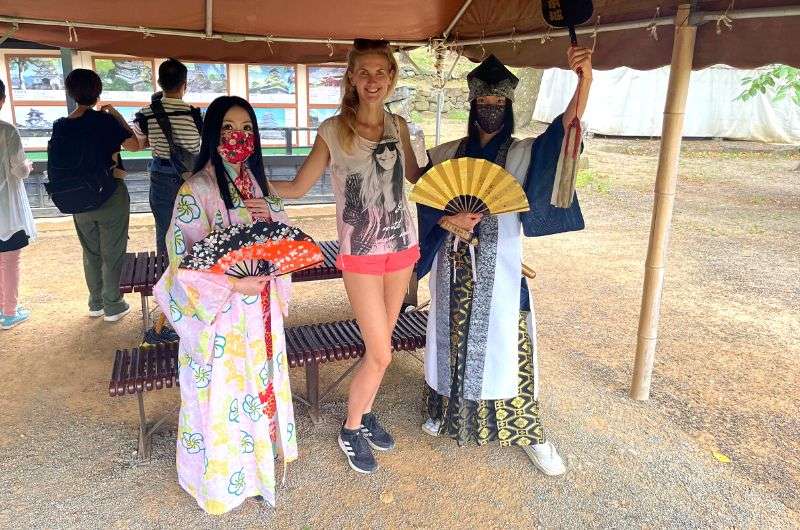
There are ninjas and samurais lurking around the gardens and my girlfriend chose to take a photo with these ladies instead?!
This national treasure, also known as ‘Crow Castle’ for its striking jet-black walls (retouched annually to keep them that way), intrigued me with its hidden floor designed for sieges—how cool is that? From the outside, you can see 5 floors, when in fact, there are 6! This extra hidden floor served as a strategic defense feature during times of siege.
Strolling up to Matsumoto Castle felt like an honor, what with the moat teeming with oversized koi that could probably arm-wrestle a small child. Back in the day, the top started leaning to the side quite a bit. We can argue that the problem was structural, but some say it’s because of a curse put on the castle by Tada Kasuke. He was a farmer that led a rebellion called the Jōkyō Uprising that demanded lower taxes. He succeeded, but a month later he was caught and executed without trial. Now he holds a posthumous grudge, apparently trying to knock Matsumoto over from the “other side”.
Inside, the 2nd floor is where it’s at. The exhibition's focus on warfare and weaponry was right down my alley, especially with its detailed how-to guides on everything from how the walls of the castle were built and about all the castle defenses, even arquebuses! Classic Japan—there’s a how-to guide for everything, even for soldiers on how to use weapons.
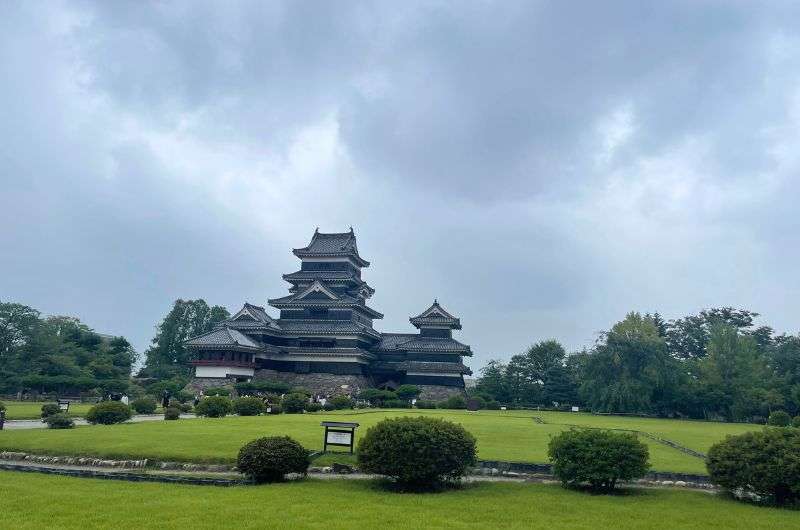
“Crow Castle” gets a paint touch-up every year to stay “crow” enough
A little warning: you'll have to ditch your shoes inside the castle, so brace for some foot odor during your tour. Also, the floors are cold, so bring good socks if you don’t want to freeze your feet (even in the summer). And be ready to walk up 140 very steep stairs to get to the very top floor.
It's exactly the castle I dreamt of as a kid, beautifully fulfilling every stereotype of a Japanese fortress. Set aside 2 hours to visit Matsumoto Castle, it’s totally worth every minute.
- Matsumoto official website
- Generally open daily from 8:30 am–5 pm
- Tickets cost JPY 700
6. The old Edo towns of Tsumago and Magome
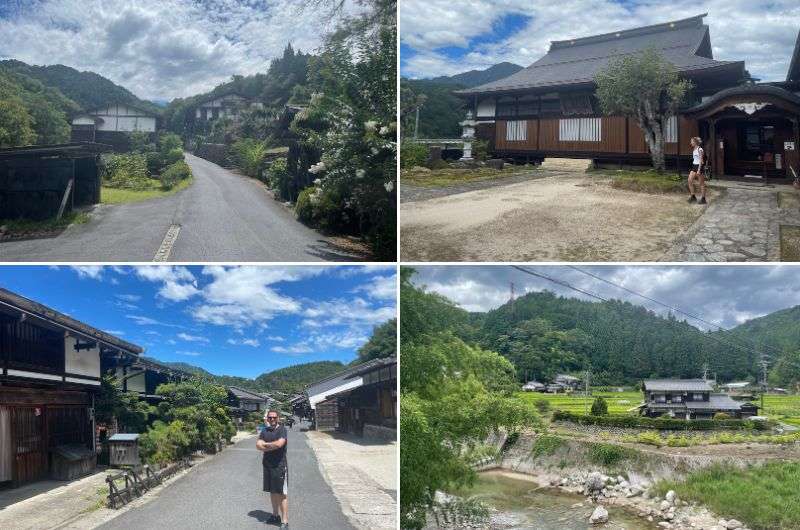
Picturesque scenes from the walk between Tsumago and Magome villages
Tsumago and Magome offer a slice of Edo period Japan with their preserved mountain village charm. They are tucked away from the hustle and bustle of Nagano, which is a nice way of saying they are far away from everything. Like, very far. It would take 3 hours to drive from Nagano to Tsumago, so unless you have a teleporter, you will want to break up the journey with a pit stop in Matsumoto or Kamikochi Valley. See how we combined everything in this exquisite Nagano itinerary.
Forget driving right into town; you park on the outskirts for JPY 500. These towns are as Edo as it gets, complete with friendly locals going about their day. I even snapped a photo with a 90-year-old gent!
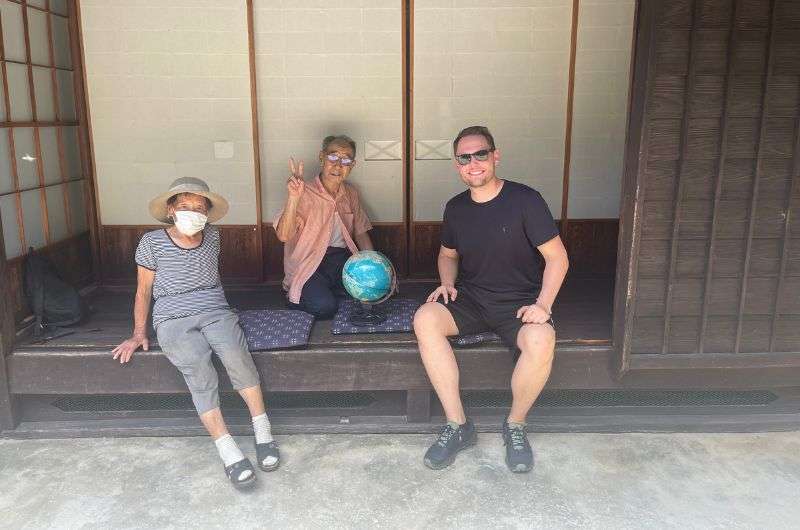
It was a nice chat with the (very old) locals!
Quick history lesson: The Edo period, spanning from 1603 to 1868 in Japan, was a time of relative peace and stability under the rule of the Tokugawa shogunate. It's known for the rise of a distinct urban culture in Edo (modern-day Tokyo), the development of the samurai class, and a flourishing of arts and culture. During this era, Japan's policy of sakoku isolated the country from foreign influence, fostering a unique development in its arts, culture, and society.
The vibe in Tsumago and Magome is all about Edo—think traditional architecture and a history lesson in every corner, especially if you add a stop at the decent local museum. You’ll know what I mean when you see the small, humble, wooden houses nestled amidst the trees, with the surrounding scenery adding to the peace. It’s what old Japan looks like in my mind (and in reality, apparently).
Linking Tsumago and Magome is a famed 7.5 km (4.6 mi) hike, part of the old Nakasendo highway that linked Kyoto and Tokyo. It’s a stroll through a forest, past a couple waterfalls, and along the traditional houses of the local residents. Some portions are along a road and the whole thing is easy despite being a steady, gentle uphill climb until about 2/3 of the way (if you’re going from Tsumago). We took 2 hours to walk to Magome and then took a bus back.
And hey, don't forget your bear bell, just in case.
7. Kamikochi Valley river walk
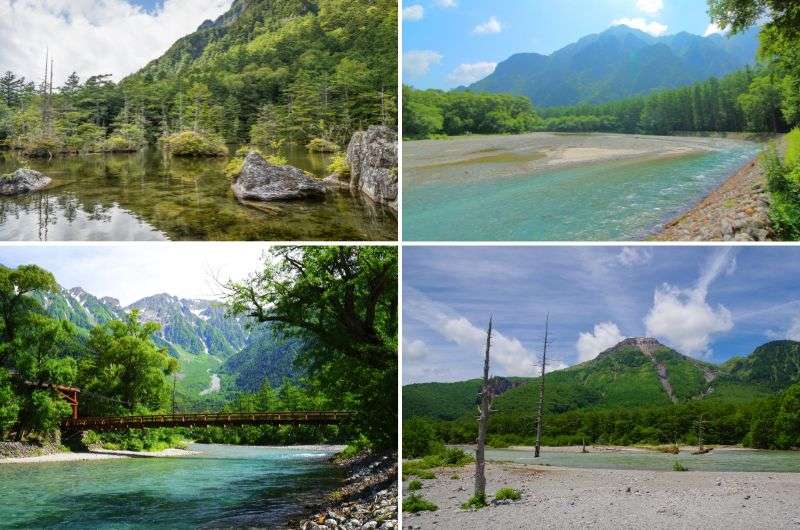
You don’t need to climb mountains to see the beauty of Kamikochi Valley
We’ve already talked about Kamikochi Valley, but I wanted to mention some alternatives to hiking up Mt. Yake. You know, in case you just aren’t up for scaling a volcano. The valley itself has enough views to fill a day, so there’s no need to actually go up to the highest heights unless you really want to.
A simple (and much flatter) way to explore Kamikochi is to simply choose one of the hiking trails along Azusa River. You’ll see the mountains, pass lakes and ponds, gaze at the clear river, and probably even meet some monkeys. Hopefully, not the bears (lots of people carrying bells in these parts for this reason).
Here are some popular options for easy walks in Kamikochi:
Taisho Pond to Kappa Bridge
Start at Taisho Pond (there’s a bus stop close by) and walk 3.5 km (2 mi) on the solid trails and boardwalks all the way to Kappa Bridge where you can cross over the river and catch the bus back again. It won’t take you longer than an hour even if you try.
Kappa Bridge to Myojin Bridge and back again
Or, for a longer route with slightly less people, start at Kappa Bridge and head out to where the buses don’t go, make your way 3.5 km (2 mi) to Myojin Bridge, cross over, and take the slightly shorter south route back. Or, if you like to leave the best for last, start south from the river and leave the much prettier northern route as the grand finale. This route is easy to do in 1.5 hours.
And if you have trouble deciding between the two, note that they can easily be connected, and there are many side-trails on the way as well. So, you could even improvise depending on how you’re feeling when you get there.
8. Daio Wasabi Farm
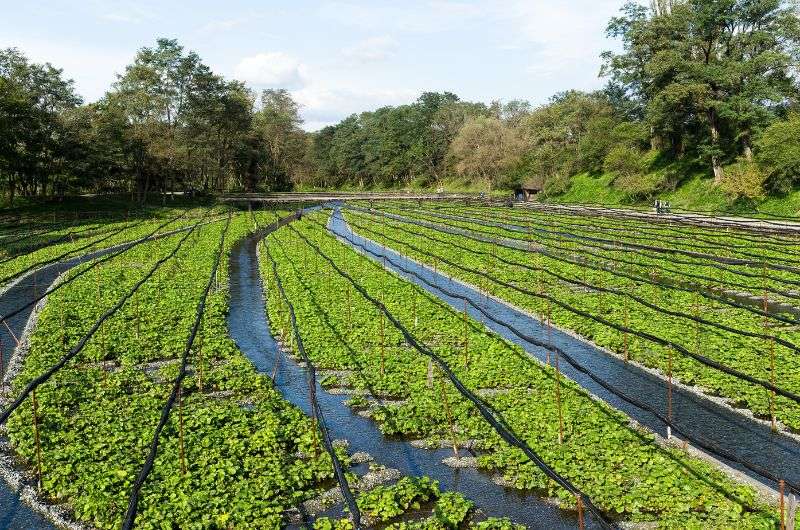
Did you know wasabi grows in flowing water??
The Daio Wasabi Farm is a great little (free) stop about an hour away from central Nagano, easy to visit as it’s close to Matsumoto Castle and even Kamikochi Valley. Actually, it’s not so little—it’s the largest producer of wasabi in the country and has been around since 1915!
And I know you’re curious about real wasabi. By that I mean not the fake stuff we’ve likely all been eating in everywhere in the world outside of Japan. More about that in my Japan Food Guide.
The Daio Wasabi Farm is a sprawling wasabi plantation that you can tour on your own on two different routes—the red trail takes 45 minutes, the blue just 20 minutes. It’s like a mini hike where you see that the whole farm is basically a flowing river! Very interesting the way they grow the plants in the water, I racked my brain a few times, haha. As a bonus, you get awesome views of the Alps, unless your visit is blanketed by a thick haze, as it was when we were there. Summers in Japan, gotta love ‘em! (Have you read about how hard it is to catch a glimpse of Mt. Fuji in the summer.)
Parking is free and there’s no entrance fee to Daio Wasabi Farm. Of course, it would be stupid not to take advantage of the tourists flowing in, so there’s a sizeable gift shop where everything is green, and several restaurants/food stalls you can taste everything from wasabi ice-cream (good!) to wasabi beer (meh). There are also paid boat tours (JPY 1200) that we didn’t get a chance to try out, but it could be a fun (but really slow?) addition to your spicy adventure.
Note that in that roughly from May to October, black tarps are used to cover the wasabi plants. It’s still worth a visit, but adjust your expectations.
Nearby is Daio Shrine, which enshrines the spirit of an ancient hero names Hachimen Daio. He is now the protector of the farm.
- Daio Wasabi Farm is open from 8 am–5 pm in spring to fall, closes at 4 pm in the winter
- Free entry
9. Jigokudani Snow Monkey Park

Look at these snow monkeys just living their monkey life
How could I make a list of attractions in Nagano Prefecture and not mention the snow monkeys. Granted, I visited Jigokudani in the summer, so there was no snow and the monkeys were hanging around for the abundance of snacks and not because they craved a warm onsen; you didn’t think there was some magical place where monkeys naturally hang out and bathe all day every day, and love being watched by tourists while they’re at it, did you?!
Jigokudani Snow Monkey Park is part of a national park that has formed around several volcanoes, so it’s a very mountainous area where hot springs and winter sports are very popular. And then there’s the snow monkey park—and it’s very much a tourist attraction. While I wouldn’t consider it a must-see, it’s still cute, and the walk to get there is nice, too.
The snow monkeys, which are Japanese macaques, naturally spend their time on higher ground, only coming down to the valley to look for food in the winter. But ever since someone got the bright idea to build an onsen pool for them (there is just 1 pool) and lure them down from the cliffs with snacks, the monkeys happily hang out at the monkey park all year round. I guess work smarter, not harder, works in the monkey society too.
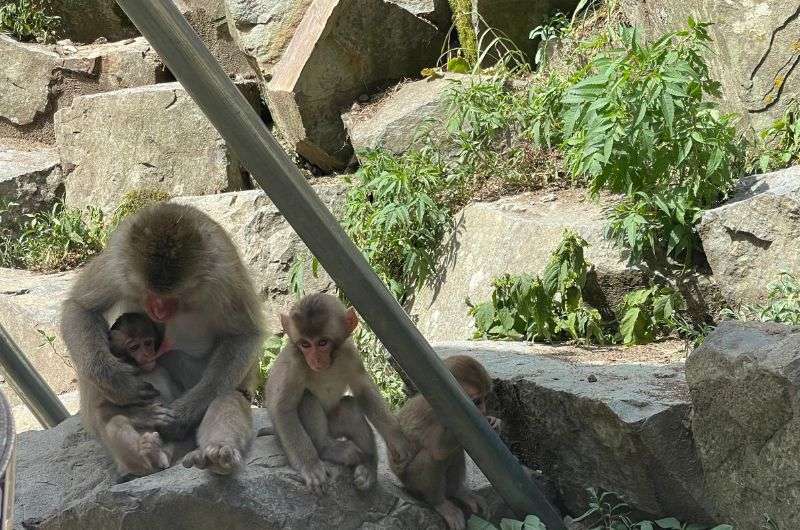
Monkey family, not bathing but still cute
If it’s not cold, the monkeys have no real interest in sitting around in the water, so the park attendants make them get in the water by throwing snacks in it. Kinda ruins the magic a little when you see it happen, but in the winter it could feel different if they’re happy to bathe in the warm water. So, while monkeys are always an entertaining species to watch, don’t come to the snow monkey park thinking you’ll find some secret monkey wonderland. It’s very much a tourist attraction.
The monkeys at Jigokudani are so used to humans staring at them, they mostly just ignore everyone and do their own thing. All the free, accessible snacks and spa treatments have resulted in some very relaxed monkeys! This allows tourists to spend some time watching them close up with a smaller rabies risk than in other places. And we saw a lot of baby monkeys, too, which was fun.
To get to Jigokudani Snow Monkey Park, you drive (or take a bus) from central Nagano for about 45 minutes and park at the bus stop close to the monkey park. Then, you walk about 20 minutes through the forest before you get to the monkey onsen. This makes it feel even more that you’re entering a wild, natural monkey bathing kingdom.
Or, you can go to the online monkey cam and check out Jigokudani monkey park right this minute!
- Open daily 8:30 am–5 pm (closes an hour earlier in the winter)
- Tickets cost JPY 800
10. Kiyotsu Gorge
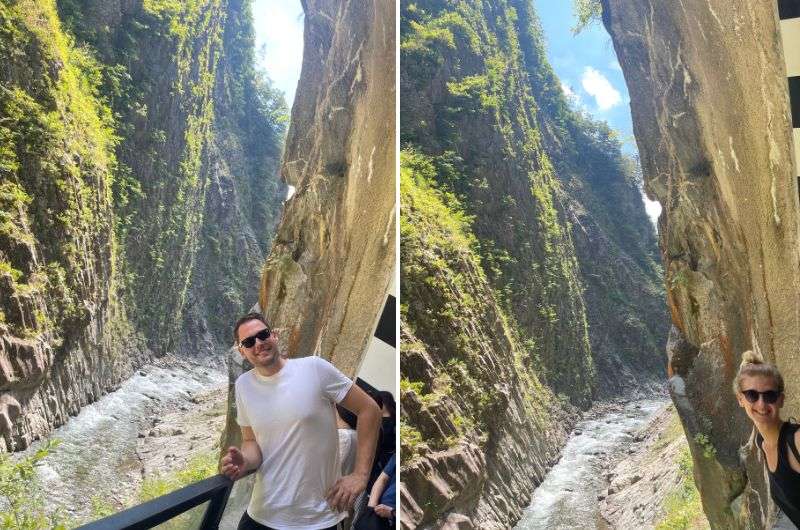
Which one of us would be better for a Kiyotsu Gorge ad?
We have gorges in Europe, right? No biggie. But unlike those in Europe (take a look at Liechtensteinklamm for example... and pretty much everywhere else I’ve experienced), Japan has a totally different concept... why put wooden walkways and stairs around what nature created when you can build a massive tunnel through the mountain and make it look like a funhouse with gorge views! Oh Japan, you are so weird!
They named it “the Tunnel of Light”, and it was good fun... you almost forget about the gorge sometimes! It’s just not something you’re used to when visiting natural attractions. There’s a pool of water at the end of the tunnel that all the kids (and Jan) very passionately enjoyed. You can apparently get some very cool photos looking out from the tunnel at that end with a mirror effect in the water... but I did too much splashing around to remember to do that.
The tunnel runs 750 m (0.5 mi) along the wall of Kiyotsu Gorge, giving you plenty of opportunities to look out and take photos. Though it seems you’ll spend just as much time taking pics inside of the tunnel, with the magic mirrors and such.
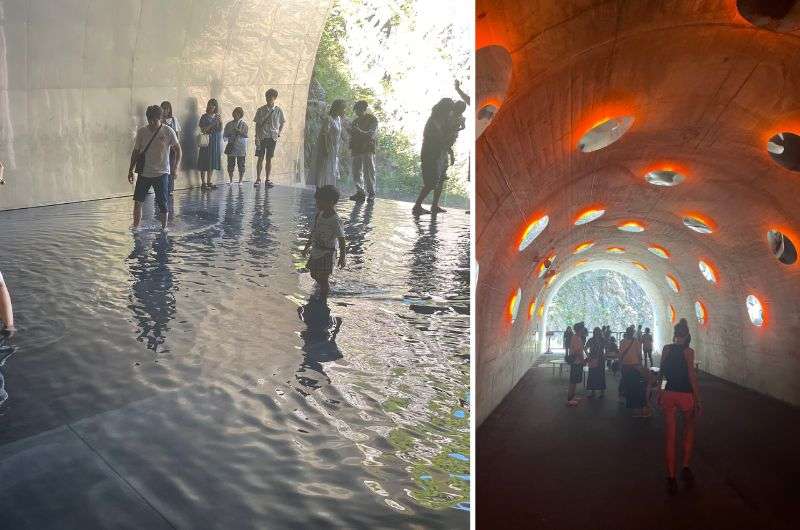
Kyiotsu Gorge is not the type of gorge experience you know from Europe! This one come complete with the Tunnel of Light
There are several parking areas at Kiyotsu Gorge, and the sooner you get there, the better spot you’ll get. Aim for the one closest to the entrance. We got there just in time to have to park in the boonies and take a 20-minute shuttle bus to the gorge entrance. Take the advice I didn’t follow myself and arrive early to save yourself the hassle.
Kiyotsu Gorge gets busy, and it makes sense to make reservations, especially in the peak summer months. You get a 1.5-hour time slot which guarantees you entrance if you get your ticket in advance.
- Kiyotsu Gorge official website
- Open daily 8:30 am–5 pm
- Tickets cost JPY 1000, advance online purchase is recommended in the summer
And that’s a wrap! Those are the 10 top things I think you should do in Nagano. If you’re ready to go, head over to my Nagano itinerary. If you need more Japan inspiration, take a look at some of my other favorite places: Nikko, Kyoto, Hakone.
If you have questions, I indeed have some FAQs for you. Here you go:
FAQ 1: How long to spend in Nagano?
A couple of days in Nagano should do it to see the top tourist attractions and some incredible nature. If you want to include some of the fantastic hikes (and I strongly recommend this), 3 days in Nagano will be better, and 4 will be golden. Check out my Nagano itinerary where you can choose how many days you want to stay.
FAQ 2: Is Nagano worth visiting in summer?
Summer is when I visited Nagano and I couldn’t contain my excitement, so I’d say yes, Nagano is great in the summer. With lush landscapes and perfect hiking conditions, I can’t think of a reason why not to go to Nagano in the summer. Just prepare for the crowds.
FAQ 3: What months can you see the snow monkeys in Japan?
The snow monkeys are year-round residents at Jigokudani Snow Monkey Park near Nagano. Winter (December to March) is when they famously soak in the hot springs voluntarily. In warmer parts of the year, the park attendants motivate them with snacks, so they sometimes go in the water to get a goodie, otherwise they just hang out around the water, again waiting for snacks. See what that looks like on the online camera (link above in item 9).
FAQ 4: Why is Matsumoto Castle famous?
Matsumoto Castle is known as "Crow Castle" due to its unique black exterior, and it's one of Japan's oldest and most significant castles. It also fulfills all stereotypes of what a Japanese castle should look like, especially if you were a kid ninja like me. It’s also cursed, and used to lean to one side, so there’s that. Get details above in item 5.
FAQ 5: How long does it take to hike Togakushi Shrine?
Plan for about 3 hours to traverse the beautiful trail connecting the five shrines at Togakushi. There’s also a side trail to the lake, which I strongly recommend, which can add another 1.5 hours to your itinerary, and the Ninja Museum, which is extremely fun, will also suck you in for quite a while.
FAQ 6: What should I do in Nagano?
The top things to do in Nagano prefecture are:
- Hike Togakushi's five shrines
- Reflect at Kagamiike Lake
- Be awed by Zenkō-ji Temple
- Wander Kamikōchi Valley
- Explore Matsumoto Castle
- Stroll through charming Tsumago and Magome villages
- Visit Daio Wasabi Farm
- See the snow monkeys at Jigokudani
- Marvel at Kiyotsu Gorge
This post contains affiliate links. I earn a small commission if you make bookings through my links, at no additional cost to you. Thank you for your support!
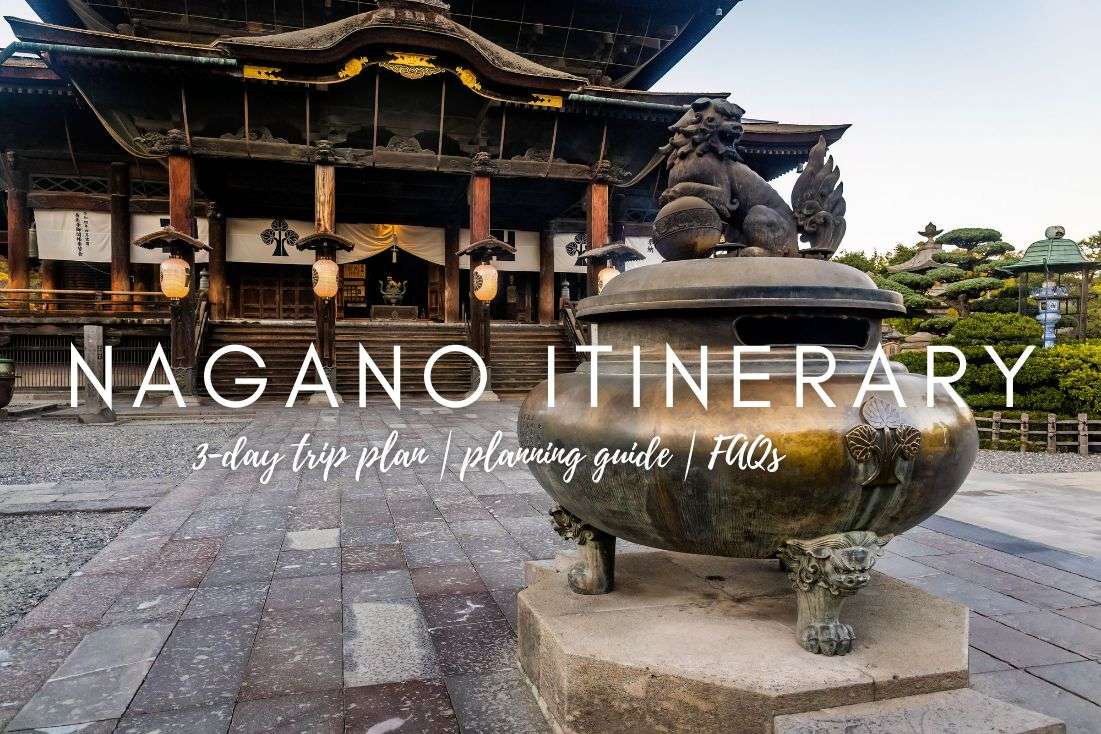
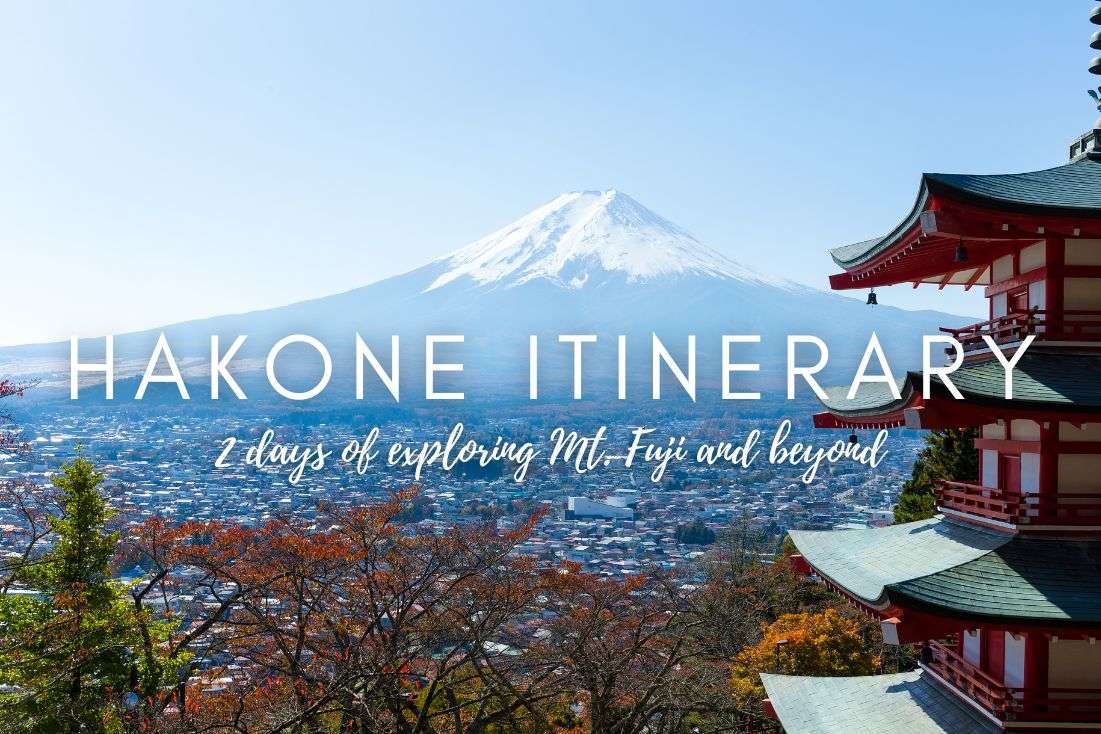
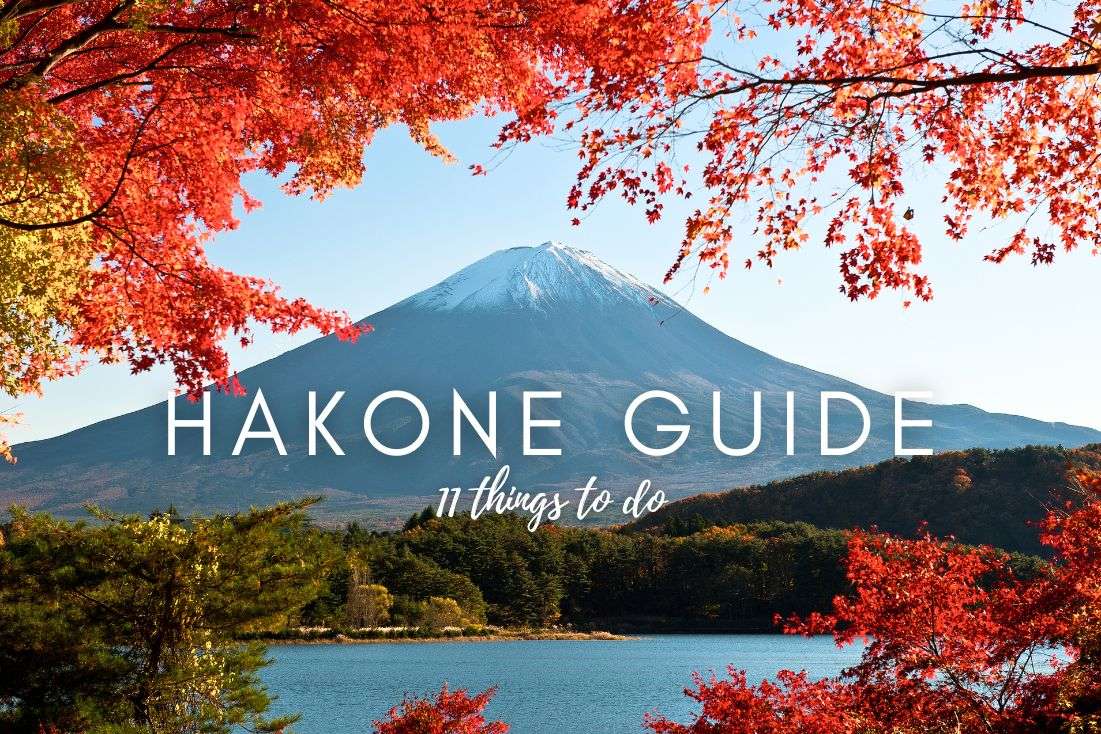




Comments
Thoughts? Give us a shout!